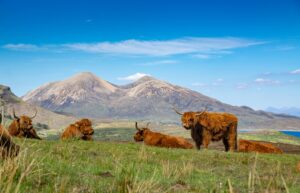A Highland Cow, often called a “Highland Coo” or “Heilan Coo,” is one of Scotland’s most iconic animals. With their long, shaggy coat and sweeping horns, Highland Cows are closely associated with the rugged landscapes of the Scottish Highlands, although today you’ll find them across mainland Scotland and the islands.
Highland Cattle date back to at least the 6th century, thriving in the rugged landscapes of the Highlands and the Western Isles. Their hardiness made them an essential part of early Highland life, and the breed has changed very little over the centuries.
They remain closely tied to the landscapes around places like Inverness, the Isle of Skye, Fort William, and the Cairngorms, where they are still commonly seen grazing in open fields.
A Highland Cow’s long coat is more than just photogenic. It’s built for survival.
They grow a unique double-layered coat:
Although many people picture Highland Coos as ginger, they come in several colours, including red, black, brindle, yellow, white, and dun.
Their distinctive fringe, known as a “dossan”, protects their eyes from wind, snow, and insects. Very practical and adorable at the same time.
A fully grown Highland Cow can weigh up to 800 kg and live for around 20 years, making them one of the longest-lived cattle breeds.
They are known for their gentle, calm nature despite their impressive horns. However, their horns can be dangerous, so always keep a safe distance and never approach them in fields, especially during calving season.
Historically, they were bred for both meat and milk, valued for their ability to thrive on steep and poor-quality grazing land.
You can spot Highland Cows in fields all over the Highlands and along popular routes like the NC500, but there are also places where visitors can reliably see them up close:
These spots in central Scotland, near Stirling, make it easier for visitors who want guaranteed sightings or photographs.
Highland Cows have become cultural icons and regularly feature on artwork, postcards, photography, and souvenirs promoting Scotland. They symbolise resilience, friendliness, and the rugged beauty of the Highlands.
You can spot Highland Cows throughout the Highlands, especially around places like Inverness, Skye, Aviemore, and Fort William. For guaranteed sightings, family-friendly spots such as Briarlands Farm and Blair Drummond Safari Park offer close-up views of Highland Cows.
Yes, are known for their gentle and calm nature, but their large horns make them potentially dangerous if approached too closely. Always keep a safe distance, avoid getting between a cow and her calf, and never attempt to touch or feed them in open fields.
Their long coat is designed for survival in harsh Scottish weather. The oily outer layer sheds rain and snow, while the soft undercoat keeps them warm in cold winds. Their long fringe, known as a dossan, protects their eyes from snow, wind, and insects.
